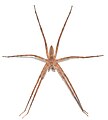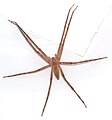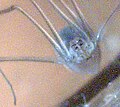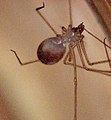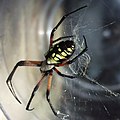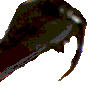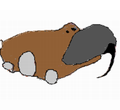User:Patrick Edwin Moran












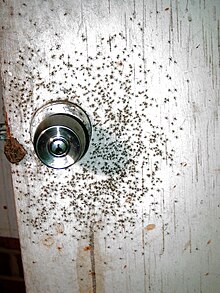

I am interested in spiders. I am located at 36° N 80° W.
Genus Avicularia
-
Avicularia bicegoi
-
Todd Gearheart thinks it may be a hybrid of A. bicegoi with A. huriana
-
Same Avic, another view
-
Avicularia metallica (immature)
-
Avicularia metallica
-
Avicularia metallica (ventral view
Genus Brachypelma
-
Brachypelma smithi female
Genus Oxiopes
-
Male Oxyopes salticus
Genus Phidippus
-
Phidippus audax (1) 10 mm. Female. She keeps a watchful eye on the photographer.
-
Phidippus audax (2) Note "lifeline" that protects her from falling.
-
Phidippus audax (3) These spiders are capable of giving defensive bites.
-
Female Phidippus johnsani (?) 14 mm.
-
Large, slow moving, and attractive, some are bright red and may tempt children.
-
These spiders will give defensive bites.
-
Phidippus octopunctatis, perhaps the largest U.S. jumping spider.
-
This female is 16 mm. long. She is very slow moving.
-
Quite calm and unobtrusive, these spiders may give defensive bites.
-
Phidippus whitmani(?) Calm but active, she seems not to fear the photographer.
-
Phidippus workmani(?) 10 mm. She is shy and wary.
-
Phidippus workmani(?) facing the camera
-
Phidippus workmani(?) orienting cephalothorax upward toward camera
-
Phidippus mystaceus 12 mm. female
Genus Thiodina
-
Note the four eyes forming corners of a square and the central white spot
-
Note the /\ pattern at the back of the carapace
-
Note that underside of spider can be seen
Genus Paraphidippus
-
Paraphidippus aurantius
-
Paraphidippus aurantius
Genus Pisaurina
-
Pisaurina sp., mira or brevipes. Male, 17mm
-
Pisaurina mira
-
Pisaurina mira
-
Pisaurina mira
-
Pisaurina mira, female
Genus Platycryptus
-
Platycryptus undatus
Tangled Web Weavers
-
female, 2 mm. May be Enoplognatha ovata or some other member of the Theridiidae. Also may be a member of the Pholcidae family.
-
Side view also shows ventral aspect
-
head, seen from the front. Note eye pattern and prominent ridges near the eyes.
-
Ventral aspect. Note ivory-like area on the soma near the cephalothorax.
-
From the side, the area near the cephalothorax can been seen to protrude and come to a point.
-
Unfortunately this spider escaped, so not all identifying characteristics were photographed.
Anyphaenidae
-
dorsal view Family Anyphaenidae,possibly a Hibana sp.
-
ventral view Family Anyphaenidae,possibly a Hibana sp.
-
Sac spider (Aysha velox)
-
Male Aysha velox
Pholcidae
Spermophora
Hogna species
-
Hogna carolinensis, female, 25mm body length.
Other species
-
Araneus cingulatus, a species that builds its web in tree crowns. It is about 4 mm. long. This spider was collected in central North Carolina, USA.
-
Digitally enhanced image of a Sphodros rufipes that shows the nearly perfectly vertical orientation of the chelicerae, a prime characteristic of the Mygalomorphae.
-
Sphodros rufipes (Atypical tarantulas)
-
G. rosea, adult, female
-
Digitally modified photograph showing "chopsticks" orientation of the chelicerae of the Araneomorphae.
-
Agelenopsis sp.
-
Agelena labyrinthica
-
Leucauge venusta
-
Argiope aurantia, hanging down in its web
-
Argiope aurantia, three-quarters facing
-
Argiope aurantia, ventral view
-
Argiope aurantia, facing view
-
Frontinella pyramitela
-
Close-up of the preceding spider
-
Florinda coccinea (Blacktailed Red Sheetweaver)
-
Florinda coccinea (Blacktailed Red Sheetweaver) (Eyes)
-
Florinda coccinea (Blacktailed Red Sheetweaver)
-
Florinda coccinea (Blacktailed Red Sheetweaver) (Eyes)
-
Florinda coccinea (Blacktailed Red Sheetweaver) (Diagram of eyes.)
-
Arctosa sp. (resembles A. leopardus)
-
Same spider, different view.
-
From North Carolina, U.S.A.
-
Length is approx. 15 mm.
-
or about .75 inches
-
These pictures are of one female.
-
Hogna helluo
-
Hogna helluo, male
-
Hogna helluo, clearly showing the eye pattern typical of this genus.
-
Hogna frondicola
-
Rabidosa, rabida. Note two black front legs. Pedipalps are lighter than shown in this photograph.
-
Dolomedes scriptus
-
Pisaura mirabilis?
-
Platycryptus undatus exploring a human thumb
-
Platycryptus undatus 1
-
Platycryptus undatus 2
-
Platycryptus undatus 3
-
Paraphidippus aurantius
-
Paraphidippus aurantius
-
Huntsman spider (Heteropoda venatoria) eating a cricket
-
The same spider is carrying an empty egg case.
-
Ventral aspect, showing epigynum and spinnerets.
-
Leucauge venusta
-
Theridion tepidariorum
-
Dorsal view 1 Note that the red dot is formed by this spider's spinerettes.
-
Dorsal view 2 The "trademark" hourglass figure is not visible.
-
Dorsal view 3 This spider has an egg sac about the size of her abdomen. It it not visible in this picture.
-
In this picture, the black widow's characteristic red hourglass is clearly visible.
-
This spider has caught an insect in her web, has wrapped it in silk, and will soon eat it.
Diagrams
Eye patterns (modified photographs)
-
Hogna species
-
Eye pattern of the orb weaving spiders.
-
Eye pattern of the Plocidae (from above).
Other
-
Cephalothorax of a typical wolf spider.
-
Body parts of the spider.
-
Eye pattern of the orb weaving spiders.
-
Eye pattern of the wolf spiders. 1. Egg sac, 2. Chelicerae, 3. Pedipalps
-
"Squared-off" cephalothorax of the jumping spiders.
-
Eye pattern of the jumping spiders.
-
Ventral diagram of the typical spider.
-
Eye pattern of the Tetragnathidae.
-
Digitally modified photograph showing "chopsticks" orientation of the chelicerae of the Araneomorphae.
-
Digitally enhanced image of a Sphodros rufipes that shows the nearly perfectly vertical orientation of the chelicerae typical of the Mygalomorphae.
-
The fang portion folds back into the chelicera as the blade of a pocket knife folds back into its handle.
-
Cut-away drawing of the cephalothorax and chelicerae, with venom glands and surrounding muscles.
-
Drawing showing how the "fang" portion of the chelicera articulates with the main part of the chelicera, and how the latter articulates with the cephalothorax.
-
There is nothing very tricky here.
-
Tetragnatha eye pattern
Physics
-
John Cramer's ansible
-
single and double split photo
-
Beam split and fuse
-
Wheeler experiment problems
-
Wheeler analog split and fuse
-
Inter-galactic Wheeler
-
multi telescope status one
-
multi telescope status two
-
backtrack Young maxima
-
Kim et al. quantum eraser
-
Kim with polarizations indicated
-
double split apparatus with two
-
double split apparatus with three
-
Approximately 1 inch black post to black post
-
Cramer ansible
-
Brian Greene, Fabric of the Cosmos, starting p. 107
-
Dribble over Strait
-
Modified Cramer Retrocausal schematic
-
12 lü and 5 scales
Other creatures
-
Black rat snake (Elaphe obsoleta obsoleta) eating a rodent.
-
Skritz, whose parents were allegedly a German Shepherd and a Yellow Labrador Retriever.
mystery tarantula 36∘11‘ 44,20 N 80∘11' 49,76 W
Outside acquisitions
-
Thiania bhamoensis, used for spider fighting in Singapore
New
https://commons.wikimedia.org/wiki/File:Thiodina_sylvana_5-die_pattern.jpg
https://commons.wikimedia.org/wiki/File:Thiodina_sylvana_venter.jpg
https://commons.wikimedia.org/wiki/File:Thiodina_sylvana_Top-down_2.jpg
https://commons.wikimedia.org/wiki/File:Thiodina_sylvana_Top-down_1.jpg
https://commons.wikimedia.org/wiki/File:Thiodina_sylvana_head-on.jpg
Notes
Do you want to have a file renamed or moved? Simply mark it like this: {{rename|the_new_name|reason_for_renaming}} and wait for an administrator or filemover to rename it.
https://commons.wikimedia.org/wiki/User:Flickr_upload_bot































